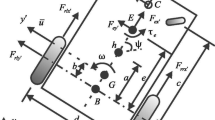Abstract
Differential wheeled mobile robot (DWMR) is a typical nonholonomic complex system with the practical importance and theoretically interesting properties. A novel backstepping & fuzzy sliding mode controller (BFSMC) is proposed for trajectory tracking of the DWMR in the presence of model uncertainties and external disturbances. Backstepping control technique is used to eliminate the pose deviations of the mobile robot based on the kinematic model. Sliding mode control is adopted at the dynamic level for velocity tracking of the driving wheels, in which the gain of switching control is adjusted adaptively by means of fuzzy logic inference, in order to mitigate the chattering problem. The tracking error convergence of the BFSMC is demonstrated by means of the Lyapunov stability criteria. Numerical simulation shows that the BFSMC has the better accuracy, rapidity, smoothness and robustness, when compared to the conventional SMC. A vision-guided mobile robot with an onboard camera is developed for the experiment of path tracking. The experimental results further validate the feasibility and effectiveness of the BFSMC.
Similar content being viewed by others
References
Vasiljević, G., Miklić, D., Draganjac, I., et al.: High-accuracy vehicle localization for autonomous warehousing. Robot. Comput. Integr. Manuf. 42, 1–16 (2016)
Ko, M.H., Ryuh, B., Kim, K.C., et al.: Autonomous greenhouse mobile robot driving strategies from system integration perspective: review and application. IEEE/ASME Trans. Mechatronics 20(4), 1705–1716 (2015)
Wu, X., Lou, P.H., Yu, J., et al.: Intersection recognition and guide-path selection for a vision-based AGV in a bidirectional flow network. Int. J. Adv. Robot. Syst. 11(39), 1–17 (2014)
Lee, S., Lee, S.: Embedded visual SLAM application for low-cost consumer robots. IEEE Robot. Autom. Mag. 12, 83–95 (2013)
Chen, W.H., Zhang, T.: An indoor mobile robot navigation technique using odometry and electronic compass. Int. J. Adv. Robot. Syst. 14(3), 1–15 (2017)
Wu, X., Shen, W., Lou, P., et al.: An automated guided mechatronic tractor for path tracking of heavy-duty robotic vehicles. Mechatronics 35, 23–31 (2016)
Yang, H.J., Fan, X.Z., Xia, Y.Q., et al.: Robust tracking control for wheeled mobile robot based on extended state observer. Adv. Robotics 30(1), 68–78 (2016)
Yang, F., Su, H.Y., Wang, C.L., et al.: Adaptive and sliding mode tracking control for wheeled mobile robots with unknown visual parameters. T I Meas. Control 40(1), 269–278 (2018)
Fukao, T., Nakagawa, H., Adachi, N.: Adaptive tracking control of a nonholonomic mobile robot. IEEE Trans. Robot. Autom. 16(5), 609–615 (2000)
Coelho, P., Nunes, N.: Path-following control of mobile robots in presence of uncertainties. IEEE Trans. Robotics 21(2), 252–260 (2005)
Rossomando, G.F., Soria, C., Carelli, R.: Sliding mode neuro adaptive control in trajectory tracking for mobile robots. J. Intell. Robot. Syst. 74, 931–944 (2014)
Lee, J.K., Choi, Y.H., Park, J.B.: Sliding mode tracking control of mobile robots with approach angle in Cartesian coordinates. Int. J. Control Auto. Syst. 13(3), 718–724 (2015)
Bessas, A., Benalia, A., Boudjema, F.: Integral sliding mode control for trajectory tracking of wheeled mobile robot in presence of uncertainties. J. Control. Sci. Eng. 7915375, 1–10 (2016)
Esmaeili, N., Alfi, A., Khosravi, H.: Balancing and trajectory tracking of two-wheeled mobile robot using backstepping sliding mode control: design and experiments. J. Intell. Robot. Syst. 87, 601–613 (2017)
Thanok, S., Parnichkun, M.: Longitudinal control of an intelligent vehicle using particle swarm optimization based sliding mode control. Adv. Robotics 29(8), 525–543 (2015)
Mehrjerdi, H., Saad, M.: Chattering reduction on the dynamic tracking control of a nonholonomic mobile robot using exponential sliding mode. Proc. IMechE Part I J. Syst. Control Eng. 225(17), 875–886 (2011)
Xu, Y.: Chattering free robust control for nonlinear systems. IEEE Trans. Control Syst. Technol. 16(6), 1352–1359 (2008)
Das, T., Kar, I.N.: Design and implementation of an adaptive fuzzy logic-based controller for wheeled mobile robots. IEEE Trans. Consum. Electron 14(3), 501–510 (2006)
Bugeja M.K., Fabri S.G.: Dual adaptive control for trajectory tracking of mobile robots. IEEE ICRA, Roma, Italy, pp. 2215-2220 (2007)
Park, B.S., Yoo, S.J., Park, J.B., et al.: Adaptive neural sliding mode control of nonholonomic wheeled mobile robots with model uncertainty. IEEE Trans. Control Syst. Technol. 17(1), 207–214 (2009)
Li, Y., Wang, Z., Zhu, L.: Adaptive neural network PID sliding mode dynamic control of nonholonomic mobile robot. ICIA Harbin, China, pp. 753–757 (2010)
Wu, H.M., Karkoub, M., Hwang, CL.: Mixed fuzzy sliding-mode tracking with backstepping formation control for multi-nonholonomic mobile robots subject to uncertainties. J. Intell. Robot. Syst. 79, 73–86 (2015)
Vicent, G., Leopoldo, A., Josep, T.: Path following hybrid control for vehicle stability applied to industrial forklifts. Robot. Auton. Syst. 62(6), 910–922 (2014)
Armesto, L., Girb, V., Sala, A., et al.: Duality-based nonlinear quadratic control: application to mobile robot trajectory-following. IEEE Trans. Control. Syst. Technol. 23(4), 1494–1504 (2015)
Wada, N., Tagami, S., Saeki, M.: Path-following control of a mobile robot in the presence of actuator constraints. Adv. Robotics 21(5-6), 645–659 (2007)
Wang, F., Chao, Z.Q., Huang, L.B., et al.: Trajectory tracking control of robot manipulator based on RBF neural network and fuzzy sliding mode. Cluster Comput. 7, 1–11 (2017)
Acknowledgements
This research work was supported by the National Defense Basic Scientific Research Program of China(JCKY2018605C004), the National Natural Science Foundation of China (61105114), the China Postdoctoral Science Foundation (2015M580421), the Key Technology R&D Program of Jiangsu Province of China (BE2014137), the Fundamental Research Funds for the Central Universities of China (NS2016050), and the Foundation of Graduate Innovation Center in NUAA (KFJJ20180513).
Author information
Authors and Affiliations
Corresponding author
Additional information
Publisher’s Note
Springer Nature remains neutral with regard to jurisdictional claims in published maps and institutional affiliations.
Rights and permissions
About this article
Cite this article
Wu, X., Jin, P., Zou, T. et al. Backstepping Trajectory Tracking Based on Fuzzy Sliding Mode Control for Differential Mobile Robots. J Intell Robot Syst 96, 109–121 (2019). https://doi.org/10.1007/s10846-019-00980-9
Received:
Accepted:
Published:
Issue Date:
DOI: https://doi.org/10.1007/s10846-019-00980-9




